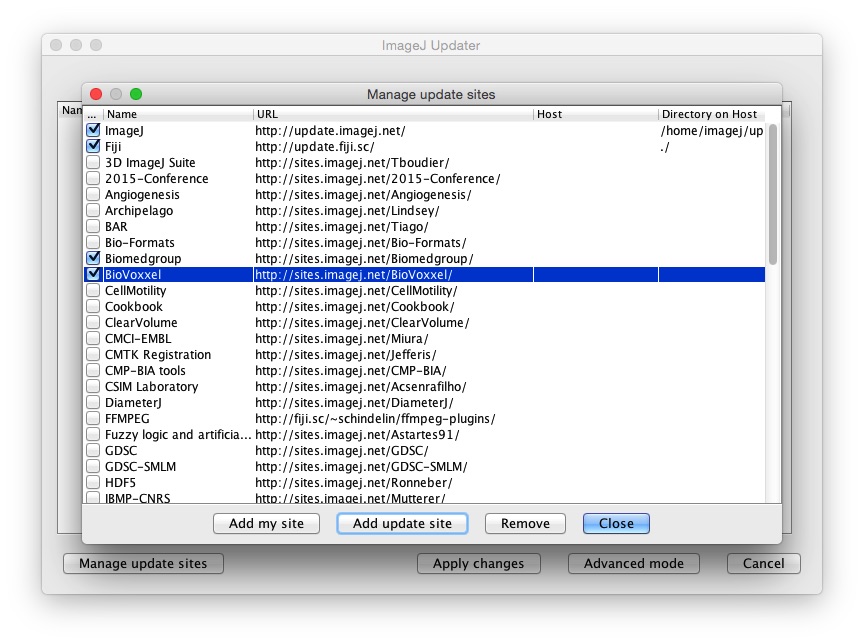- 5Other downloads
- 5.2Life-Line Fiji versions
ImageJ for Mac, free and safe download. ImageJ latest version: Scriptable Java app for scientific image processing. ImageJ Download Instructions for Students last edited by Kim Moore 9 months ago General Instructions: How to Download ImageJ (w/ 'Manual Tracking' and 'MultiTracker' plug-ins.) One of the modern tools that we will use is an image/video analysis software called ImageJ. Students will learn more about this in the pre-reading to a future lab (Lab 1b). Download Latest Version for Mac ImageJ - A Powerful Image Processing Tool 1/4 ImageJ is an excellent software for examining various types of digital photographs. ImageJ runs on the PC with a Java interface and is a free download. Trapping plugin illustrator. ImageJ becomes very slow after running for a while. There are several reasons ImageJ can run slowly on macOS. Java painting bug. On OS X, older versions of Java 8 (prior to 1.8.045)—as well as all versions of Java 7 (including 1.7.080)—are extremely slow at displaying images. Download ImageJ 1.53 for Mac. Fast downloads of the latest free software!
Files for download include (1) Fiji (Fiji Is Just ImageJ) package (.tar file) suitable for download (with and without Java Run Time) and (2) example images suitable for testing these tools. Further description to follow. ImageJ is a macOS image editing application that offers you the possibility to preview, edit, analyze and print image files using your Mac. Java based multi-platform image editor. The ImageJ app has been developed for the Java platform which means that it can be used on a wide selection of different operating systems, as long as they came with support for the Java runtime (e.g. MacOS, Linux. /download-sublime-text-editor-for-mac/.
Fiji is a distribution of ImageJ which includes many useful plugins contributed by the community.
| ~ Download Fiji for your OS ~ | ||
|---|---|---|
64-bit | macOS | 64-bit |
| Other downloads | ||
Fiji is supported on the following systems:
- Windows XP, Vista, 7, 8 and 10
- Mac OS X 10.8 'Mountain Lion' or later
- Linux on amd64 and x86 architectures
However, Fiji (like ImageJ) should run on any system for which a Java 8 runtime is available (Solaris, Raspbian, etc.).
Packages for Debian / Ubuntu
We used to offer Debian packages of Fiji. Unfortunately, for a variety of reasons, we are withdrawing support for these packages until such time as someone is able to maintain them properly, so please switch to using the Linux downloads above instead.
If you are a Debian packaging expert who would like to address this situation, we would love to have your help—please join us in chat or on the forum.
Fiji is distributed as a portable application. That means that you do not have to run an installer; just download, unpack and start it.
- Many common questions are answered on the FAQ.
- If you encounter bugs, please see the Getting Help page.
See the source code page for details on obtaining the Fiji source code.
Archive
You can download previous Fiji builds by date stamp from the archive.

Life-Line Fiji versions
This sections offers older downloads of Fiji, preserved just prior to introducing major changes. The idea is that if something goes horribly wrong, you can fall back to a stable version.

Java 8
Here are Life-Line versions of Fiji created after the switch to Java 8.
| Date | Downloads | Description | |||||
|---|---|---|---|---|---|---|---|
| 64-bit | 32-bit | macOS | 64-bit | 32-bit | no-JRE | ||
| 2017 May 30 | Just prior to a sweeping update to nearly all components. | ||||||
Java 6
Here are Life-Line versions from before Fiji switched to Java 8.
| Date | Downloads | Description | |||||
|---|---|---|---|---|---|---|---|
| 64-bit | 32-bit | macOS | 64-bit | 32-bit | no-JRE | ||
| 2017 May 30 | The final version of Fiji using Java 6, for all platforms. | ||||||
| 2015 December 22 | Just prior to starting the transition to Java 8. | ||||||
| 2014 November 25 | Just prior to a big update to facilitate reproducible builds. | ||||||
| 2014 June 02 | Just prior to some big changes to ImageJ2 under the hood. | ||||||
| 2013 July 15 | Just prior to extensive changes reconciling Fiji with ImageJ2. | ||||||
See also
- https://downloads.imagej.net/fiji/ for early versions of Fiji, and other miscellany.
- The main Downloads page, for a version of ImageJ without the Fiji extensions.
Last Updated:
OS: Mac OS X 10.10/10.11/10.5 Intel/10.5 PPC/10.6 Intel/10.7/10.8/10.9
Size: 6 MB
Download Imagej For Macbook
Category:Digital Photo SoftwareDownload Imagej For Windows 7
ImageJ for Mac free download latest version for MAC, ImageJ for Mac is a Photo Editors software, This application is Developed and maintained by NIH.
Imagej Download For Macbook Pro
ImageJ is a public domain Java image processing program inspired by NIH Image for the Macintosh. It runs, either as an online applet or as a downloadable application, on any computer with a Java 1.1 or later virtual machine. It can display, edit, analyze, process, save and print 8-bit, 16-bit and 32-bit images.
It can read many image formats including TIFF, GIF, JPEG, BMP, DICOM, FITS and “raw”. It supports “stacks”, a series of images that share a single window.
How To Use Imagej
It can measure distances and angles. It can create density histograms and line profile plots. It supports standard image processing functions such as contrast manipulation, sharpening, smoothing, edge detection and median filtering. It does geometric transformations such as scaling, rotation and flips.
Download Imagej For Windows 10
ImageJ for Mac screen shot
Imagej 64 Bit
- >>>
- >>>
- >>>
- ImageJ
How to uninstall ImageJ on Mac computer? If you encounter problem when trying to delete ImageJ as well as its associated components, read through this removal tutorial and learn about how to perfectly remove any unwanted applications on your Mac.
Things you should know about Mac app removal:
_Logo.svg/1200px-FIJI_(software)_Logo.svg.png)
ImageJ for Mac free download latest version for MAC, ImageJ for Mac is a Photo Editors software, This application is Developed and maintained by NIH. ImageJ is a public domain Java image processing program inspired by NIH Image for the Macintosh. Download imagej mac for free. Design & Photo downloads - ImageJ by Wayne Rasband and many more programs are available for instant and free download.
Uninstalling applications in macOS/Mac OS X is quite different from that in Windows operating system. In normal cases Mac users just need to simply drag and drop the target app to the Trash and then empty the Trash to perform the standard uninstallation. Generally speaking, most Mac applications are separate bundles that contain the executable and any associated resources for the app, and therefore users can easily remove any unwanted software (if they are installed properly) from their Macs.
However, a fact is often neglected that, even the stand-alone software may might still leave its configuration and preferences files on multiple system directories after you carry out a basic uninstall. These vestiges can be very small in size, thus leaving them alone may not affect your Mac performance, yet they can also be a large chunks of useless files that occupy a large portion of your hard drive space. In the latter case it is quite necessary to clean out those junk files from your Mac for complete removal.
For some novice users, they may have no idea how to remove ImageJ in a proper way. Even for the experienced users, they may also get lost when trying to uninstall a problematic, stubborn or even malicious application. In this post we will discuss the following questions: (1) What is the correct way to uninstall ImageJ ? (2) How to ensure all its accompanying components are removed safely? And (3) is there a shortcut for both Mac novices and experts to take to accomplish ImageJ removal effortlessly?
Conventional Steps to Uninstall ImageJ for Mac
Prior to the removal of ImageJ , you should first log into your Mac with an administrator account, and turn ImageJ off if it is running. To deactivate an app, right click its icon in the dock and select Quit option (or choose ImageJ > Quit ImageJ on the Menu bar).
Also, you can access the Activity Monitor (located in /Applications/Utilities/ folder), and see if there is any background process pertaining to the app. If ImageJ cannot be quit normally, you can select the app in Activity Monitor, click the large red “Quit Process” button in the left corner and click Force Quit button in the pop-up dialog.
Option 1: Drag ImageJ icon to the Trash
- Open up the Finder, click Applications on the left side, and then select ImageJ .
- Drag ImageJ to the Trash (or right click on it and then select Move to Trash option).
- Right click the Trash icon and select Empty Trash option to start the uninstall.
Imagej Macro For Batch Processing
This drag-to-delete method works in all versions of Mac OS X. Most 3rd party apps can be smoothly uninstalled in that way, but you cannot delete built-in apps by doing this. Some apps installed using the Mac package installer will prompt you for a password when you try to move it to the Trash. In any case you cannot move ImageJ to the Trash or empty the Trash, try holding the Option key as you choose Empty Trash from the Finder menu, or reboot your Mac and try it again later.
Warming: It is important to point out that, emptying the Trash will instantly wipe off ImageJ as well as other files you’ve thrown into the Trash, and that this act is irrevocable, so make sure you haven’t mistakenly deleted anything before emptying the Trash. Any time you change your mind and wanna undo the deletion of apps or files, just right click the item in the Trash and select Put Back option.
Option 2: Delete ImageJ in the Launchpad
- Open up Launchpad, and type ImageJ in the search box on the top.
- Click and hold ImageJ icon with your mouse button until it starts to wiggle. Then click the “X” that appears on the left upper corner of ImageJ to perform the uninstall.
This tap-and-hold method is applicable for the apps installed through the App Store, and it requires OS X lion or later. Once you click the X icon, the uninstallation of ImageJ will be handled immediately, and there is no need to empty the Trash afterwards. This way cannot uninstall built-in apps as well.
Option 3: Launch ImageJ built-in uninstaller
Imagej Download For Mac Windows 10
It is worth mentioning that, some applications for Mac come with their own dedicated uninstallers, e.g. Adobe and Microsoft. Those apps will install additional software to provide extended functions, or place library files and associated application dependencies elsewhere in OS X. You can manually delete all the accompanying components as well, but it would be better to run the specialized uninstaller to fully remove the application alone with its bundled software or associated items.
- Locate the ImageJ installation file and double click to open it up.
- Select the [uninstaller] in the package and double click to run it.
- Follow the onscreen prompts to complete the uninstalling process.
Imagej For Macbook Air
To uninstall the software and plugins that don’t show up in the Application folder or come with a uninstaller, you are supposed to go to their official websites and look for their own downloadable uninstallers or the uninstallation instructions provided there. As for some apps that are built in macOS, you can either run commands in the Terminal to delete it, or try the uninstall tool offered in the last section of this post.
Imagej Fiji Download
Delete ImageJ Library Files, Caches & Preferences
Most OS X application are self-contained packages that can be easily uninstalled by dragging them to the Trash, but there are exceptions too. Some of you may wonder if the classic methods mentioned above help remove the associated files or folders created by ImageJ . Well, even though completely uninstalling apps on OS X is much more simple than that on Windows, you may need to check if there are support and preference files left on your hard drive after ImageJ has been deleted. ImageJ vestiges may not do much harm to your system but do take up a certain disk space. Therefore, if you are not gonna use ImageJ any more, these remnants can be deleted permanently.
There are tow locations where apps store their preferences and supporting files, and both are named Library. Apart from these files, ImageJ may also scatter its components like login items, startup daemons/agents, or kernel extensions around the system.
To remove all the traces of ImageJ from your Mac, do the following steps:
Part 1. Top Level Library on Hard Disk: /Library
- Open the Finder, click on the Go from the Menu Bar, and select Go to Folder.
- Type the path of the top level Library on hard disk: /Library, and hit Enter key.
- Search for the items with the name of ImageJ in the following locations:
- /Library
- /Library/Caches
- /Library/Preferences
- /Library/Application Support
- /Library/LaunchAgents
- /Library/LaunchDaemons
- /Library/PreferencePanes
- /Library/StartupItems
- Right click the matched files or folders, and select Move to Trash option.
Part 2. User Library inside Home Folder(~/Library)
- Head to Go > Go to Folder, type ~Library in the box and hit Enter key.
- Identify and delete the similar named files or folders in the same set of folders:
- ~/Library
- ~/Library/Caches
- ~/Library/Preferences
- ~/Library/Application Support
- ~/Library/LaunchAgents
- ~/Library/LaunchDaemons
- ~/Library/PreferencePanes
- ~/Library/StartupItems
- Empty the Trash to delete ImageJ leftovers permanently.
Application components may appear in a wide range of locations, including but not limited to the aforementioned file paths. For instance, some antivirus and security software will install additional kernel extensions which are by default located in /System/Library/Extensions. For the leftovers that are not obvious to identify, you might do a Google search for the app components, and perform the removal carefully.
Manually deleting ImageJ leftovers can be a laborious task for inexperienced Mac users. If you are still not sure how to delete app remnants entirely, or you would like to save time in removing ImageJ alone with all its remnants, well, utilizing a professional removal tool is a better option for you, compared with the manual removal.
Effective Solution to Thoroughly Remove ImageJ
Look for an all-in-one solution to handling any application removal on your Mac? You might need the help of a specialized and advanced Mac uninstaller, which will spare you from the tedious searching for app vestiges. A outstanding uninstaller should be featured by intuitive interface, easy operation, powerful performance, and satisfactory effects. Now you can get all of these features in Osx Uninstaller.
Utilizing Osx Uninstaller can be the most effective way to remove any corrupted, stubborn and malicious application for your Mac. It will scan your whole system for every piece of target application and then remove them in one click, thus to finally free up your Mac hard disk space. Continue reading to know more about this tool.
Q1: How to remove ImageJ by using Osx Uninstaller?
Step 1. Launch Osx Uninstaller in the Launchpad after quiting ImageJ in the Dock. Step 2. Select ImageJ on the interface and click Run Analysis button to scan ImageJ .Step 3. Click Complete Uninstall in Step 2, and click Yes to confirm removal.
Step 2. Select ImageJ on the interface and click Run Analysis button to scan ImageJ .Step 3. Click Complete Uninstall in Step 2, and click Yes to confirm removal.After you click Yes in the dialog, the uninstall process will be activated immediately, and you will be informed that ImageJ has been successfully removed. The whole process is quite straightforward (3 steps: launch - select - remove), and it may take only a few seconds to complete. Fast and simple, right? Just give it a try now!
Q2: Why is it better to apply Osx Uninstaller?
A clean uninstall of unwanted application is what most computer users desire for, but manually hunting down app stuffs is never an easy job to do. Once you start to use Osx Unisntaller, there is no need to manually locate app files left behind any more. You will save the trouble of crawling over the system looking for ambiguous remnants, and you don’t have to deal with various uninstall problems that may occur.
Osx Uninstaller, an high-efficient uninstall utility designed for Mac, helps remove not only the built-in applications but also the software and plugins that don’t appear in the Application folder. You can download this removal tool for free and try it out first. If you think it meets your demand, you can pay for the full version.
Summary: This guide offers several approaches to uninstall ImageJ on Mac. The manual ways require more time and skills to ensure a clean, complete uninstallation, while the automated uninstaller could handle any app removal smoothly and swiftly.
Imagej For Mac High Sierra
Mac Tips & Tricks: How to Manage Startup Items?
Thank you for reading this post. Does it help resolve your uninstall issues? We will be glad if you share your thoughts or any suggestion about this removal guide.